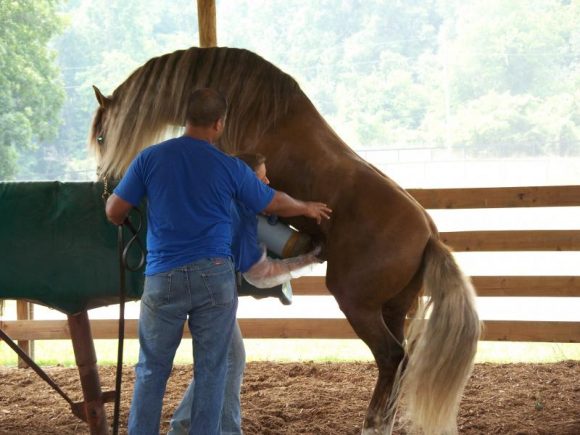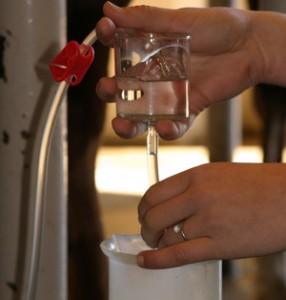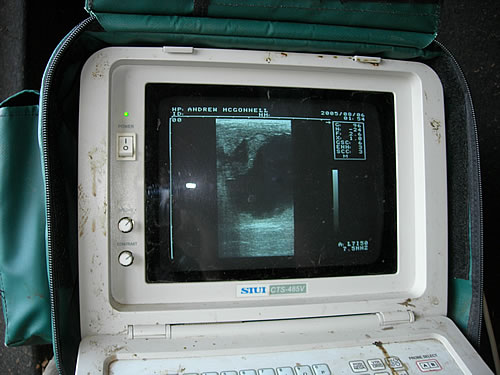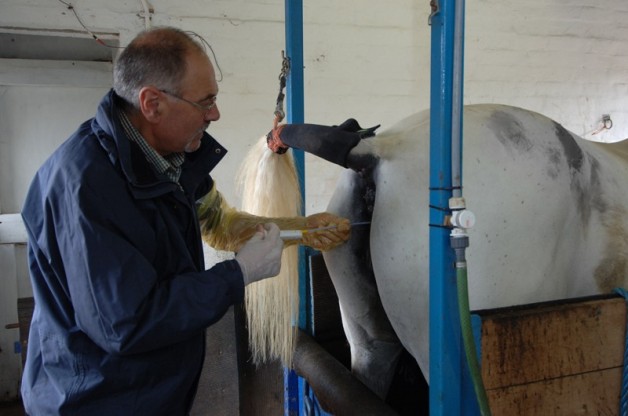Infertile mare? Deceased dtallion? No problem! Equine reproduction has become high-tech enough to overcome these hurdles and more
Over the past three decades horse breeding has migrated from the farm to the laboratory. Clinical facilities now serve as the backdrop for many equine reproduction efforts—particularly those involving poor fertility or difficulty sustaining a pregnancy. In fact, nowadays neither the mare nor the stallion even have to be present or alive to produce healthy offspring.
The following is an overview of available and forthcoming technologies for horse breeders dedicated to overcoming the most daunting odds to produce that special foal.
 The Stallion Side
The Stallion Side
Since the advent of modern artificial insemination (AI) in the 1970s and the improved art of shipping cooled and frozen semen a few years later, there have been few major new high-tech procedures introduced for breeding stallions. That said, researchers continue to look for ways to improve sperm quality and approaches for cooling, freezing, storing, and shipping semen—particularly from stallions whose semen doesn’t respond well to one or more of these procedures.
Artificial insemination
AI was the first frontier of advanced reproduction techniques and remains a mainstay. Today, the only major equine registry still holding out against using AI is The Jockey Club, which registers Thoroughbreds. Because the procedure is quite straightforward, many breeding farm owners offer this service, as they or their employees have learned through university or clinic short courses how to collect stallions and inseminate mares with good success.
Semen freezing
Several labs provide commercial equine semen freezing and storage services, but few breeding farms do, as it requires special facilities and equipment. These labs’ objective is to provide horse owners and veterinarians with the latest research and technology available for preserving and storing equine semen.
A stallion usually first undergoes a complete breeding soundness evaluation to detect any abnormalities. A stallion’s semen is frozen using the optimal method for that individual stallion.
When a young stallion is gelded, or when a stallion dies unexpectedly, it is possible to immediately harvest his spermatozoa. A veterinarian can remove the testes and associated epididymides (duct system) and send them to an equine reproduction lab for processing and semen freezing and storage. However, owners should ideally collect and freeze semen from a valuable stallion while he’s still alive and before an unexpected tragedy occurs.
 The Mare Side
The Mare Side
“It’s all about optimization,” says Elaine Carnevale, DVM, PhD, associate professor in biomedical sciences at Colorado State University’s Adams Equine Reproduction Laboratory. “Much of what we do helps extend the reproductive life of mares by using such technologies as embryo transfer, ICSI (intracytoplasmic sperm injection), oocyte transfer, and other therapies. We often deal with older mares, and the ultimate goal involves healthy pregnancies and healthy foals.”
Embryo transfer
This technology has been around for more than 30 years but still plays an important role in many breeding programs. It also is widely available, as a fair number of veterinary practitioners and breeding farms have the capability to perform the procedure.
With embryo transfer, a pregnant mare “donates” an embryo (extracted on Day 7 or 8 of gestation) to a surrogate recipient dam to complete gestation and delivery. Embryos also can be cooled to 5°C (41°F) and shipped to a farm or facility for insertion into a recipient mare on the appropriate estrous cycle.
Embryo Transfer Step-by-Step
Challenges remain because the technology needed to stimulate mares to superovulate (release eggs from more than one follicle at a time, which increases the chances of recovering a viable embryo) is not yet commercially available. A company has produced and patented an effective recombinant equine follicle-stimulating hormone (reFSH) to achieve this, but it does not yet manufacture or distribute it. Gonadotropin-releasing hormone (GnRH) therapy (to stimulate follicle development and facilitate maturation and ovulation) might enhance the chance of “double ovulations,” but the product is just now being considered for commercial availability.
Oocyte transfer (OT)
This technique is newer than embryo transfer and involves removing a recipient mare’s oocyte (egg) and placing a donor mare’s oocyte into the recipient’s oviduct. From there, veterinarians use traditional artificial insemination to fertilize the egg, and the embryo begins to develop. This method circumvents any problems involving the oviduct, uterus, and cervix and allows mares that cannot produce embryos or carry a pregnancy to produce offspring through a surrogate.
Typically, a veterinarian uses transvaginal aspiration (TVA) to harvest mature or immature oocytes for an OT procedure (or for ICSI procedures in the lab, as we’ll describe later). While it is easier to harvest mature oocytes, they are more sensitive to environmental influences, and shipping and handling sometimes ruins them. Immature follicles are more difficult to harvest, but are less fragile.
Ovary transport
When a valuable mare dies, a veterinarian can harvest her ovaries, collect the oocytes to mature in a lab, and either place them in recipient mares for fertilization and gestation or fertilize them in the lab using the ICSI procedure before placing them in a recipient. (Embryos also can be frozen for later use, which we’ll discuss shortly.) To improve the odds of achieving healthy embryos through this process, breeders should use high-quality semen.
Success rates are best if the veterinarian recovers the eggs less than eight hours after death. The ovaries should remain at body temperature during transportation if the trip is shorter than two hours, or at room temperature if transport takes longer. “For ovaries, the faster the better,” Carnevale says. “And 24 hours is the maximum time.”
 Intracytoplasmic sperm injection
Intracytoplasmic sperm injection
Unlike in humans, in vitro (in the lab) fertilization (IVF) in horses is extremely difficult because the equine sperm cell is usually unable to penetrate the oocyte’s outer membrane—in essence, the egg’s shell—outside a mare’s reproductive system. Very few live foals have been born using IVF.
Therefore, scientists developed the ICSI technique for use when it becomes necessary to fertilize oocytes outside the body or when only a limited number of sperm are available for use from a subfertile or deceased stallion.
The ICSI procedure starts when a veterinarian recovers one or more oocytes from a mare’s ovarian follicles and cultures them in a lab until they reach maturity. Using a high-powered microscope and special instruments, a technician injects a single sperm cell into the mature oocyte’s cytoplasm. This procedure’s approximate success rate for fertilizing oocytes is 30%.
The practitioner then cultures the fertilized egg for seven to 10 days, during which time cells divide and it becomes a blastocyst that can be transferred into a recipient mare for gestation.
Katrin Hinrichs, DVM, PhD, Dipl. ACT, professor and Patsy Link Chair in Mare Reproductive Studies at Texas A&M University, has seen the use of ICSI increase in recent years. “In 2011 we did 47, in 2012 we did 63, in 2013 we did 150, and this year we did 468,” she says. “About 75% of procedures (in our clinic) result in an embryo, and then about 75% of those result in a pregnancy. So, I would say that the overall success rate is about the same as ET, about 50% pregnancies per donor mare cycle.”
Taking the procedure one step further, a new method heralded by Carnevale and her team (JoAnne Stokes, Jacobo Rodriguez, DVM, and Patrick McCue, DVM, MS, Dipl. ACT) promises to make ICSI available to a wider group of horse owners and breeders. For the first time clinically, the group successfully performed an ICSI and implanted the fertilized embryo back into the original donor mare on the same cycle—without the need for or expense of a surrogate mare. While this method shows promise and resulted in three foals born in 2014, it might not work for some horse owners because the donor mare still needs to be capable of carrying the pregnancy to term.
“This new process makes ICSI much more accessible and affordable for people to continue the legacy of some of these really valuable stallions,” says Carnevale. “We can still produce offspring, even with poor sperm quality or limited supplies, but at about a quarter of the cost.”
In-vitro fertilization
As described above, basic IVF doesn’t work well with horses thanks to the egg’s outer membrane. Until recently, researchers thought it was because incubation conditions that induce the whiplike tail motion needed to penetrate an egg in other species fail when used with equine sperm.
Back in 2009, Cornell University researchers used the local anesthetic procaine to force hyperactivity (the whip motion) in equine sperm and achieved a 61% fertilization rate. Procaine is toxic to embryos, however, so it’s not a practical solution.
As it turns out, the challenge has less to do with a sperm’s agility and strength and more to do with its need to achieve capacitation, or undergo changes making it capable of fertilizing an egg. These changes are difficult to recreate in vitro.
Researchers at Cornell and Texas A&M have been working to understand why, and they’re getting closer to the answer.
Texas A&M’s Leticia Vivani, DVM, MS, who works jointly in the labs of Hinrichs and Dickson Varner, DVM, MS, Dipl. ACT, also from Texas A&M, believes there is something special within a mare’s reproductive tract that causes capacitation that other species do not need. One theory involves using the right pH—one that’s more alkaline than acidic.
“One recent study reports that scraping the oviduct lining and using that material on the IVF procedure did result in sperm capacitation,” says Edward Squires, PhD, Dipl. ACT(hon), of the University of Kentucky’s Gluck Equine Research Center, who has long specialized in stallion reproduction research. “While it really isn’t a very practical solution, it does give us more information as research on this continues.”
Blue light therapy
Recently, scientists have developed an artificial light technology to advance the natural breeding season, which coincides with the light-filled days between May and September. “Low-intensity blue light of the correct wavelength has been shown to stimulate receptors in the eye that are responsible for inhibition of melatonin production,” explains Jerry Longworth, VMD, of Select Breeders Services, an international network of equine reproduction labs.
The company Equilume developed a light mask that attaches to a halter and provides low-level blue light to one eye. It is battery-powered and on an automatic timer (the battery should last for the entire breeding season). The light turns on when daylight levels drop at dusk, remains activated for seven hours, and then turns off. The process repeats the next evening.
Research results have shown that mares wearing the light masks and mares put under lights indoors began cycling similarly, which effectively advanced the breeding season. This new technology could provide breeders with more flexibility: Mares could be kept outside—a perk for mares that don’t like stalls, and breeders could save money on bedding, labor, and electricity.
Embryo freezing
Veterinarians have frozen small, young embryos over the years with success, but they’ve found vitrifying (freezing) older embryos can be problematic. Fortunately, Hinrichs’ biopsy research revealed a way to freeze larger embryos with implantations resulting in pregnancy rates above 50%.
Hinrichs says that removing cells for biopsy causes the blastocyst to collapse due to the loss of fluid; a smaller volume of fluid inside probably allows for less damage during the freezing process.
Genetic testing
Hinrichs and colleagues recently completed a study in which they found that a high-tech genetic analysis of embryo biopsies is more than 95% accurate. “We are very excited with this, as it is a method that has the potential to eliminate genetic diseases in a breeding program in just one generation and, conceivably, in an entire breed,” she says. In the simplest terms, here’s how the procedure works:
During embryo transfer the retrieved embryo is sent overnight to the lab and the biopsy is performed the next day using cells from a small portion of the placental area, a technique that protects the embryonic cells (those of the developing foal itself). The practitioner can then implant the embryo into a recipient or save and vitrify it to be warmed (thawed) and then implanted after the genetic testing is complete, which takes about a week. It is now available to any breeder and can also determine embryo gender.
“With this procedure available, a mare owner can breed to a stallion with superior characteristics but who may be carrying a genetic disease,” explains Hinrichs. “We can determine if the embryo is a carrier or will actually suffer from the condition. At that point, the mare owner can decide to not use that embryo. On the other hand, if the embryo is completely free of the disease and is not a carrier, the mare owner can decide to go forward with the pregnancy and make use of the positive genetic characteristics available from the mare and the stallion.”
This means neither mare nor stallion owner will have to limit their mating choices.
Fertility Studies
Researchers at universities and clinics around the country are studying basic mare fertility. Their efforts will no doubt soon solve other sections of the equine reproduction puzzle, including:
Biofilm
A uterus can test “clean” even when bacteria and fungi are hiding out “under a dome,” or biofilm. Once a mare becomes pregnant, those nasty bits head out to wreak havoc and end the pregnancy. CSU’s Ryan Ferris, DVM, MS, Dipl. ACT, and Brad Borlee, PhD, are among those studying this issue.
Faster test results
McCue and Ferris are working on a test to detect bacterial and fungal DNA in a mare’s uterus that reveals results in as few as one to two hours, instead of 24 to 72 hours. This could transform uterine infection diagnosis in the future the way it already has in human medicine and allow earlier, better-pinpointed treatment.
Metabolic syndrome
Overweight older mares often have metabolic issues that affect fertility, with changes to their follicles, fluids, and more. Studies on equine metabolic syndrome’s effect on mare fertility are ongoing at several universities, including CSU, Virginia Tech, and the University of Kentucky.
PGE2 uterine tube application
A research team comprised of Ferris, McCue, and others found that topical application of prostaglandin E2 gel (a hormone that causes the oviduct to relax, allowing the fertilized egg to pass) to uterine tube surfaces via a laparoscopic procedure improved embryo recovery rates or pregnancy rates in 28 subfertile mares, with embryos produced or a pregnancy obtained in 24 of these.
Maternal recognition of pregnancy
The mechanism causing this remains a mystery. Although we know embryo contact with the uterine surface is important, the manner in which the embryo conducts a signal is elusive. One hypothesis, being studied by CSU professors Jason Bruemmer, PhD, and Gerrit Bouma, PhD, is that focal adhesion molecules in the uterus trigger maternal recognition of pregnancy. This discovery could help improve existing fertility control methods in wild horses, as well as shed light on pregnancy losses.
Take-Home Message
The state of high-tech equine reproduction is constantly changing and improving due to the many researchers across the country and around the world who are dedicated to producing high-quality horses and improving the breeds so many enjoy.




As a breeder who has promoted ‘natural living’ for the Arabian(& all horses) for the past 30 years, & only ever used natural breeding methods I find the statement that “Over the past three decades horse breeding has migrated from the farm to the laboratory.” at the very least, ‘quite sad’ & on a personal personal note ‘extremely disturbing’.
Although I understand the need to bring fresh bloodlines to a breeding program, & that some of those bloodlines may be in another country, I still feel there are other ways to refresh ones bloodlines.
Also it may be worth mentioning that in all the years I have been breeding Arabians I have happily purchased mares who are apparently impossible to get ‘in foal’ & believed infertile, & have always managed to get the mare ‘in foal’ naturally with no human interference, or handling.
Conversely I was told that a stallion I shipped over from the USA would never be able to be used to cover mares naturally as he “runs the mares into the ground”. Within 6 months of his arrival he had covered 2 mares naturally & went on to live with his band of mares quite happily for the next few years with 100% fertility & absolutely no injury to either himself or his mares.
Sadly I am sure very few people will support my beliefs these days, believing them to be out dated & old fashioned but whatever happened to allowing a horse to actually live like a horse, don’t we owe them that much if we love them as much as we claim to love them.